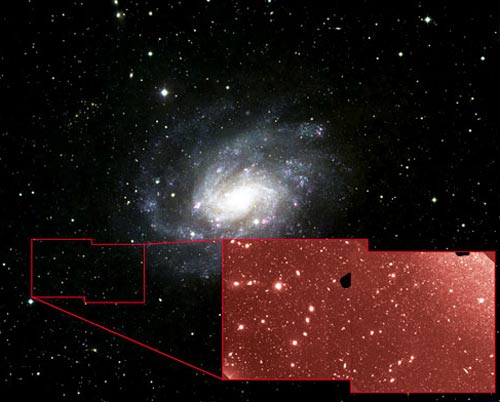A team of Australian and American scientists has determined NGC 300, a spiral galaxy located in the constellation Sculptor, is larger than previously believed — possibly by a factor of 2 or greater. In light of this discovery, not only will astronomers have to adjust the known size of the galaxy, but they also will have to reconsider the sizes of other spirals.
Using the Multi-Object Spectrograph on the Gemini South Telescope in Chile, the team examined NGC 300. Contemporary beliefs held that observations would reveal the galaxy’s star counts would fall off sharply at some radius. The Gemini astronomers hoped their star-counting technique would provide a more accurate view than previous studies of NGC 300. Instead, they found faint stars up to 47,000 light-years from the galactic center and no fall-off. The stellar disk extends farther with these ancient stars, doubling the disk’s previously known radius.
Prior observations incorrectly measured the star numbers in NGC 300 because of the faintness of the extended stellar population. As team member Bruce Draine told Astronomy, superior equipment is required for a precise analysis.
“Previous studies lacked the sensitivity to accomplish this,” says Draine. “The Gemini South Telescope, together with excellent seeing conditions, permitted reliable measurements of the number of stars per area in NGC 300 down to very low values.”
This finding has implications closer to home. Our Milky Way Galaxy could be much larger than its existing estimate of 100,000 light-years.
“Our galaxy is much more massive and brighter than NGC 300, so on this basis, our galaxy is also probably much larger than we previously thought — perhaps as much as 200,000 light-years across,” explains Joss Bland-Hawthorn, chief author of the team’s paper.
Beyond the Milky Way, astronomers also need to answer how spiral galaxies can form with stars located so far from their core. To solve this quandary, “deeper” observations must be made with powerful instruments like the Gemini South Telescope. Good news for the NGC 300 band of researchers: Gemini has granted them more time with the Chilean observatory to hunt for clues.
The team’s findings are in the August 10, 2005, issue of The Astrophysical Journal.










